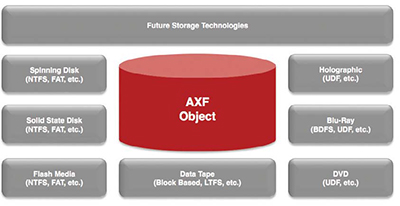Strategies for Better LTO Data Preservation

AXF’s IT-centric design is applicable to M&E as well as enterprise.
HAMILTON, N.J.—In the next few months, SMPTE is expected to publish specifications for a new SMPTE standard called the “Archive eXchange Format,” which provides capabilities that improve long-term content archive and preservation.
While AXF supports interoperability among disparate content storage technologies—including hard drives, flash media, optical discs, and SANs—its greatest benefit may be for linear magnetic data tape technologies such as Linear Tape-Open.
LTO stores massive amounts of data on a single Ultrium data-tape cartridge, and its storage capacities are increasing exponentially. Today’s LTO-6 can store 2.5 TB on a single cartridge with a data transfer speed of 160 MBps, while its LTO- 5 predecessor handles 1.5 GB (140-MBps data speed). LTO-7 and LTO-8, in development, will reach 6.4 TB with 315 MBps and 12.8 TB with 472 MBps respectively.
INTRODUCING AXF
Data can be recorded onto LTO using either Linear Tape File System or Tape ARchive recording formats; but LTFS is the one favored by the broadcast industry. While LTFS is a file system that manages how files are stored on data tape so you can find and access them, AXF is a wrapper for a storage object. It’s designed to be harmonious with any storage technology, operation and file system.
“AXF provides the same functionality of LTFS while adding significant long-term archive, preservation and resiliency features,” said Brian Campanotti, chief technology officer of Front Porch Digital in Louisville, Colo. Front Porch implemented an early SMPTE design for AXF, then provided all the intellectual property—covering what it learned to make AXF practical—gratis to SMPTE to benefit the industry.
But Campanotti said that LTFS is not an official standard, it’s open source, and when vendors make subtle changes to it, to make it work on their devices, they’re inherently making it proprietary.
“In the past, we saw many cases where users could not access their legacy content where vendor-specific open-source implementations such as TAR were used,” Campanotti said. “As organizations became more concerned about openness, long-term accessibility and preservation, LTFS and now AXF were developed to address this proprietary challenge.”
When storage systems are AXF compliant, customers are no longer locked into a proprietary storage solution and any type or size data can be stored or retrieved regardless of the content storage management application or storage media used.
Tens of petabytes of media and non-media content are already being transported, stored and protected by AXF worldwide.
FILE FORMAT FLEXIBILITY

Paul Moran, SGL's chief technology officer and managing director According to Merrill Weiss, chairman of the SMPTE Working Group on AXF and president of Merrill Weiss Group, LLC in Metuchen, N.J., “if content owners want to use LTO for storage, they have the option to apply AXF to obtain many benefits on any and all generations of LTO.”
For example, for those who want to continue using LTO-4—an older version of LTO that doesn’t support the LTFS file system— AXF enables them to use that media in a standardized way without having to upgrade their hardware and other software,” he added.
If they’re using LTO-5 or LTO-6, which do support LTFS, AXF is another option because it works compatibly with LTFS. But Weiss said, “AXF provides services that go beyond what file systems can do. AXF explicitly tells you the relationships between groups of files and folders and their metadata.”
Other capabilities include: built-in redundancy, checksums for reliability, provisions for forward error correction, and the ability to move content efficiently between different types of storage media as well as stream content between local storage and the cloud.
COMPATIBLE TECHNOLOGIES
According to Phil Storey, CEO of XenData, a manufacturer of archive systems for the media and entertainment industry based in Walnut Creek, Calif., “there is a common misunderstanding that AXF and LTFS are competing formats which is just not the case. They’re two completely different things that are in fact complementary. LTFS is a data-tape file system, and AXF is a file wrapper.”
Storey added that LTFS is widely adopted especially for use with LTO-6 and LTO- 5 cartridges and is critical for interoperability and interchangeability. Using the AXF file format on LTO cartridges written with the LTFS file system is an excellent approach, he said. LTFS is essentially a de facto standard because virtually all vendors in this industry adhere to the specification and implement it in exactly the same way.
“With LTFS, the industry has a data tape interchange standard that supports file system access,” Storey said. XenData supports AXF files written to LTO cartridges written using the LTFS file system.
“Using LTFS is the key to having interchangeability between third-party data tape systems,” Storey said. “An AXF file can be recorded onto LTO tape, but LTFS has to be used as well. Without it, customers can’t be sure the data on their tape cartridges can be read by other vendors’ systems.”
WAIT AND SEE APPROACH
Many vendors will wait for the AXF standard to be finalized by SMPTE before making their products AXF compliant. One such vendor is For-A, which markets the Video Archiving Recorder, an LTO/LTFS product line that includes the LTR-100HS (MPEG-2) and LTR-120HS LTO-5 (AVC Intra/ DVCPRO) models. Both systems are available as either LTFS/LTO-6/LTO-5 or as LTFS/LTO-5 only.
“We welcome the AXF initiative and once it’s a SMPTE standard, we’ll gauge its acceptance in the industry, and our engineers will see what customer benefits we can provide by migrating our product line to the AXF standard,” said Andrew Alexander, vice president of For-A for Canada in Toronto.
WSB-TV Uncovers Video Gems in Vast LTO Archives
WSB used Nexidia’s Dialogue Search to track down video of Martin Luther King’s “I have a Dream” speech from the original ABC feed—on LTO data tape. ATLANTA—As Atlanta’s news leader, WSB-TV2 spent over 18 months digitizing its vast archive of over 40,000 hours of media content amassed over several decades of news reporting. But the Cox Media Group station soon realized it was impractical to search this massive archive to quickly find content needed for news reports.
“Many of our digital assets were in danger of languishing in the archive simply because we didn’t have the resources to log them properly, which made them difficult if not impossible to find in a search,” said Gary Alexander, director of engineering at WSB-TV.
Cox Media Group’s systems integrator, Bridge Digital, then recommended Dialogue Search, which searches for spoken words or phrases across massive libraries in seconds. After installing it in August 2013, WSB producers tried it to find content for a news segment about the civil rights movement planned for Martin Luther King Day, Jan. 20, 2014.
After using the solution to index their archive, which took 80 hours, they ran a search and in five minutes they found media no previous search had found—video of Martin Luther King’s entire “I Have a Dream” speech from the original ABC feed—on LTO data tape.
“By adopting Nexidia Dialogue Search, we can now easily discover content we never would’ve found otherwise,” said Alexander. “We then send the information to our MAM system and follow our established production processes to insert content into stories… and make better use of our media library.”
According to Drew Lanham, senior vice president and general manager of Nexidia’s Media and Entertainment division, “Dialogue Search gives WSB-TV a way to find critical bits of content from the past it wouldn’t have otherwise found and merge it into today’s stories.”
—Claudia Kienzle
While customers are starting to store media files in the cloud, For-A’s Alexander said that storing large, valuable archives on data tape offers cost-effective, long-term benefits including easier disaster recovery from off-site LTO back-ups. By adding a secondary drive, For-A’s recorders can dual-record copies for master and back-up simultaneously.
NOTHING BEATS TAPE
SGL, a U.K.-based manufacturer of content storage management solutions for the broadcast industry, has been involved with the development of several standards including AXF.
But “SGL has found that LTFS—being an IT standard for a non-proprietary tape format—fits customers’ needs more appropriately,” said Paul Moran, the company’s chief technology officer and joint managing director. Workflows involving LTFS are now in production allowing customers’ assets to be shared between different archive manufacturers and IT workflows.
“We know that video data will need to pass into and out of archive applications on LTO tape,” Moran said. “So wrapping with AXF within the archive requires a rewrap when exporting the video assets. This is not required with LTFS.”
While the data stored on most video archives is enormous, Moran says their reuse is low, around 15 percent in the company’s experience. So the challenge is to store the data at the lowest cost for very long periods. The need to keep storage costs low also applies to cloud-based archives.
“Cloud storage can be managed as a tier within a hierarchical storage archive, but the cost of restore, and providing guaranteed bandwidth for accessing the assets, can be off-putting,” Moran said. “When calculating the cost of storing video data— and factoring in power, infrastructure, cooling, monthly fees and labor costs—nothing beats tape in the long term.”
For more information on AXF, visitwww.openaxf.org.

Get the TV Tech Newsletter
The professional video industry's #1 source for news, trends and product and tech information. Sign up below.

